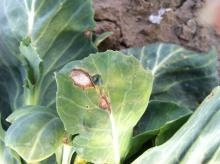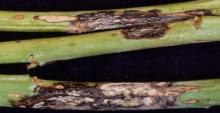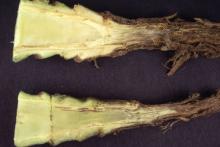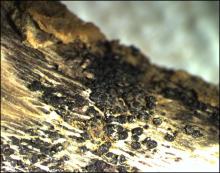See:
Seed Crop, Crucifers (Brassica, Eruca, and Raphanus spp.) - Black Leg
By C. M. Ocamb
Cause Plenodomus lingam (syn. Leptosphaeria maculans, anamorph: Phoma lingam) and Plenodomus biglobosus (syn. Leptosphaeria biglobosa) are fungi that can infect a range of cruciferous crops. Host plants include Brassica species (broccoli, Brussels sprouts, collards, canola, kale, mizuna, mustard greens, rutabaga, turnip, etc.), Sinapis (white and yellow mustard), and Raphanus (daikon and radish). Cruciferous weeds common in the Pacific Northwest can be host to black leg, including: birdsrape mustard (Brassica rapa), black mustard (B. nigra), western yellow cress or curvepod yellowcress (Rorippa curvisiliqua), tansymustard (Descurainia pinnata), hedge mustard (Sisymbrium officinale), tumble mustard (S. altissimum), small tumbleweed mustard (S. loeselii), pennycress (Thlaspi arvense), mouseear cress (Arabidopsis thaliana), annual wallrocket (Diplotaxis muralis), perennial wallrocket (D. tenuifolia), and wild radish. The fungus survives on living plants as pycnidia, which produce water-splashed pycnidiospores, or with plant debris as pycnidia and/or pseudothecia. Pseudothecia release ascospores that may be windborne long distances, at least several miles and perhaps further on storm fronts. The fungus survives in association with infected plant residues until the plant debris decomposes (up to 5 years). In fall-sown crops or winter weeds, new pseudothecia can form on dead portions of infected plants prior to plant death and continue forming on infected residues remaining on the soil surface after harvest. In spring-sown crops, pseudothecia do not form on dead portions until after harvest, and their production on residues atop the soil typically starts the following fall after a couple of wet periods. Ascospores are released from the pseudothecia following wet or humid conditions and when mean temperatures are between 46°F and 59°F. It has been reported that ascospore release by P. lingam and P. biglobosus under controlled conditions occurs at temperatures between 41°F to 68°F. Ascospores germinate at temperatures between 41°F and 68°F, but ascospores of P. biglobosus may germinate more rapidly compared to P. lingam. Germination of ascospores by both of these fungal species occurs more quickly in the higher range of temperature compared to 41°F, with 59-68°F being the optimum but temperature, cultivar, and tissue type are all important factors modulating ascospore germination. Non-germinated ascospores can potentially survive days to months in the absence of a host, and ascospores of P. lingam exposed to dry air survived longer than those of P. biglobosus. Conditions conducive for ascospore production and release commonly occur during the fall, winter, and springtime throughout the Pacific Northwest. Trap plants deployed weekly in multiple sites around the Willamette Valley in western Oregon beginning in October 2014 and 2015, showed that the first ascospore infections occurred around mid-October. During 2015-2016, ascospore infections of trap plants occurred from mid-October into May with severe disease pressure during February and March. The periods of higher ascospore release and infections of plants will depend on the environmental conditions. Ascospores infect through natural openings in the plant surface or via wounds; wounding of plants by insects, herbicides, or other mechanical means can increase disease incidence and severity. After successful infection of a leaf, hyphae will grow between the mesophyll cells towards the petiole and then along the vascular tissues, in or alongside the xylem vessels. Plenodomus lingam growing from an initial leaf lesion can ultimately result in stem cankers subsequently developing as cortical tissues in the stem are colonized, and this fungus can eventually invade the tap root, causing rot of roots, especially of the tap root or storage roots.
Two types of pycnidia (which produce asexual spores known as pycnidiospores or conidia) can be found; one on infected, live plants (thinner-walled pycnidium with a neck) and the other on crop residues (thicker-walled pycnidium with a narrow ostiole). Conidia are dispersed by splashing rain or irrigation water, so conidial movement is limited to relatively short distances, but conidia can add to the overall incidence and severity of disease build-up within a field. Workers or equipment moving through infected plantings during wet conditions can spread disease. The process by which conidia of P. lingam and P. biglobosus infect plants is similar to that of the ascospores. The germination of conidia occurs at temperatures ranging between 41°F and 77°F. Examination of conidial inoculations using a set of P. lingam and P. biglobosus isolates on a set of differential cultivars of canola showed that a higher relative humidity level can increase the aggressiveness of P. lingam as well as the virulence of P. biglobosus.
The black leg fungus can also move with infected seed, Leptosphaeria can survive for years in association with seed. But if, as a general practice, seed lots used for planting are Leptosphaeria-free then the spread of regional epidemics is thought to arise from infected plant debris. Even low levels of seed infection, when coupled with weather favorable for disease, can lead to severe losses, including stand die-out within a field. The Oregon Department of Agriculture requires that all crucifer seed, even half ounce or smaller packets, that is to be planted in Oregon must be accompanied by an official test showing that the untreated seed is free from black leg (Leptosphaeria species).
This disease can reduce vegetable and seed yields. After a disease outbreak in a larger geographic area, the threat of seed yield loss in fall-sown crops is much greater due to the abundance of affected crop residues on the soil surface, especially if field-wide epidemics occurred in no-till production. Widespread leaf spot and subsequent black leg stem cankers can result from unprotected plants being exposed to ascospores released from infected crop residues. Replanting or allowing volunteers to grow in a field after a black leg outbreak can result in high numbers of infected seedlings by fall in western Oregon or Washington Brassica seed fields, perpetuating disease. Planting adjacent to a previously-infected field can result in a high disease incidence (40 to 60%) in a new planting by December while planting within a few miles of an infected residue site can result in generalized infections across new fields (1 to 5%). Researchers at OSU have observed uncontrolled black leg infections in fall-planted seed fields in western Oregon increase from a low disease incidence (1% to5%) to high (40% to 90% of the stand infected) in a 6-week period. Infections of fall-planted vegetable or seed fields can lead to stand losses through winter into the spring. Secondary diseases are common on plants with black leg; Sclerotinia, Botrytis, and soft rot bacteria are especially common on black leg-infected plants in western Oregon during rainy weather and may mask black leg infections by six weeks later.
Symptoms Generalized leaf spots, becoming numerous across the field, have been observed in fall-planted crops after initial windblown spore (ascospore) infections. Pale, irregular spots develop on cotyledons, leaves, stems or petioles, later becoming somewhat circular to oval, ashy-gray colored with scattered tiny, black pycnidia. Sometimes the center of lesions will fall out, especially after heavy rain-fall, but a narrow, ashy-gray band with pycnidia usually remains. The lower leaves of cabbage will typically have leaf spots that develop on the underside. Stem cankers develop after the fungus grows systemically down the plant from initial leaf spots and are elongated with purple-black borders in cauliflower but less distinct on cabbage. Stem cankers typically develop at the soil line, and may girdle the stem as well as decay pith tissues, and extend below the soil surface, causing a brown-to-gray to black rot in the lower stem and roots. Vascular tissues may turn black in color prior to development of external black leg symptoms. Damping-off can occur if plants are infected at the seedling stage, usually through the use of infected seeds. Plants produced from infected seeds that survive the seedling stage are stunted and often develop a rot of the stem at or just below the soil line, which moves upwards and can cause plant death.
Sampling The states of Oregon and Washington require that all crucifer seed planted in the respective states must be accompanied by an official test stating that the untreated seed is free from black leg (Leptosphaeria species). Plant clinics, including the OSU Plant Disease Clinic, can test seed lots suspected of having seedborne Leptosphaeria prior to stock seed samples being submitted for official tests. Seed stock can be assayed for the causal organism in official tests conducted by a number of labs. The following labs are certified to officially test seed lots that require Leptosphaeria testing before distribution in the state of Oregon:
Agri Seed Testing, Inc. (1930 Davcor Street SE, Salem, OR 97302; Tel: 503-585-1440; Fax: 503-588-0733; Email: office@agriseedtesting.com; http://www.agriseedtesting.com)
Eurofins STA Laboratories (1821 Vista View Drive, Longmont, CO 80504; Tel: 303-651-6417; Fax: 303-772-4003; Customer Service: 800-426-9124; Email: stacoinfo@eurofinsus.com)
Iowa State University Seed Laboratory (109 Seed Science Center, Iowa State University, Ames, Iowa 50011-3228; 515-294-6826; Email: seedlab@iastate.edu; http://www.seeds.iastate.edu/seedtest/)
Oregon Department of Agriculture, Commodity Inspection Program, Salem, OR (Fax: 503-986-4737; Email: seedservices@oda.state.or.us)
Oregon State University Seed Laboratory (3291 SW Campus Way, Corvallis, OR 97331; Tel: 541-737-4799; Fax: 541-737-2126)
Cultural control
- Plant only seed certified by official testing to be free of Leptosphaeria.
- Rotate out of crucifers for at least three years.
- Control susceptible weeds and manage volunteer crucifers during rotations.
- Avoid planting in or adjacent to a site where disease has occurred within the last 3 to 4 years; plantings within a quarter of a mile of a field containing Leptosphaeria-infected crucifer residues are at high risk for developing black leg.
- Delay spring plantings until the weather is drier to avoid periods of ascospore release.
- Bury residues after harvest by deep plowing if possible, or remove plant debris. Buried turnip residues had increased rates of decomposition, compared to residues left on the soil surface, in OSU studies by Berry. Flailing residue reduced the population of Leptosphaeria spp. compared to no-till and shallow-tillage treatments. Flailing the crop residues once, followed by a deeper incorporation (greater than 2 inches deep), may be sufficient as long as the residue remains buried for several years, depending on amount and size of plant debris as well as environmental conditions.
- Hot water seed treatment for 25 min. in water at 122°F for cabbage, 20 min. for cauliflower.
- For organic production, removal of affected leaves shortly after leaf spots develop, can reduce secondary spread within a planting as well as the incidence of stem cankers.
Chemical control Seed treatment and a foliar fungicide program will be essential if growing seed fields in any region where black leg epidemics have occurred across a larger geographic area. Infected seed can occur in seed lots, certified to be free of Leptosphaeria, at levels below the detection threshold by seed testing, and chemical or hot water seed treatments will aid in controlling disease introduced by infected seed.
Plant seed treated with a fungicide:
- Coronet fungicide seed treatment (Group 7 + 11) at 5.1 to 6.2 fl oz/100 lb seed (commercial seed treaters only) plus a dye. Studies conducted by OSU and WSU have shown Coronet at the higher rate to be a very effective treatment for seedborne Leptosphaeria and other fungi.
- Mertect 340-F (Group 1) at 0.002 mg ai/seed is labeled for control of Fusarium diseases in cabbage and will aid in controlling seedborne Leptosphaeria in Oregon only. Studies conducted by OSU and WSU have shown Mertect to be an effective treatment for seedborne Leptosphaeria.
If leaf spots are observed in a planting, foliar sprays will help to reduce the build-up within the field:
- Cabrio EG (Group 11) at 12 to 16 oz/A, maximum of two (2) applications per crop. Do not make more than one (1) application of any Group 11 fungicide before alternating to a labeled fungicide with a different mode of action. Preharvest interval is 0 days. 12-hr reentry.
- Inspire Super (Group 3 + 9) at 16 to 20 fl oz/A on 7- to 10-day intervals is labeled for other diseases on leafy brassicas and can be applied to aid in controlling black leg in Oregon only; apply in the fall as wet weather get under way. Make no more than two (2) sequential applications. Preharvest interval is 7 days. 12-hr reentry.
- Priaxor Xemium Brand (Group 7 + 11) at 6 to 8.2 fl oz/A on 7- to 14-day intervals. Do not make more than one (1) application of any Group 11 fungicide before alternating to a labeled fungicide with a different mode of action. Preharvest interval is 3 days. 12-hr reentry.
- Quadris Top (Group 11 + 3) at 12 to 14 fl oz/A is labeled for other fungal diseases on leafy Brassicas and can be applied to help control Leptosphaeria in Oregon only. Do not make more than one (1) application of any Group 11 fungicide before alternating to a labeled fungicide with a different mode of action. 4-hr reentry. Do not apply within one day of harvest. 12-hr reentry.
- Tebuconazole formulations (Onset 3.6L, Tebustar, Monsoon, Tebu-Crop 3.6F, Toledo 3.6F, etc.) (Group 3) at 3 to 4 fl oz/A on 10-day intervals is labeled for other diseases of brassicas and can be applied to aid in controlling Leptosphaeria in Oregon only. Chinese cabbage only. Do not apply within 7 days of harvest. 12-hr reentry.
References Berry, P.A. 2019. Decomposition of Brassicaceae Residue in the Willamette Valley. Ph.D. Dissertation. Oregon State University.
du Toit, L.J., Derie, M.L., and Morrison, R.H. 2005. Evaluation of fungicide seed treatments for control of black leg of cauliflower, 2004. Fungicide & Nematicide Tests 60:ST011.
El Hadrami, A., Fernando, W.G.D., and Daayf, F. 2010. Variations in relative humidity modulate Leptosphaeria spp. pathogenicity and interfere with canola mechanisms of defence. Eur. J. Plant Path. 126(2):187-202.
Huang, Y.J., Fitt, B.D.L., Jedryczka, M. Dakowska, S., West, J.S., Gladders, P., Steed, J.M., and Li, Z.-Q. 2005. Patterns of ascospore release in relation to phoma stem canker epidemiology in England (Leptosphaeria maculans) and Poland (Leptosphaeria biglobosa). Eur. J. Plant Pathol. 111:263-277.
Huang, Y.J., Toscano-Underwood, C., Fitt, B.D.L., Todd, A.D., West, J.S., Koopmann, B., and Balesdent, M.H. 2001. Effects of temperature on germination and hyphal growth from ascospores of A-group and B-group Leptosphaeria maculans (phoma stem canker of oilseed rape). Ann. Appl. Biol. 139(2):193-207.
Miller, S.A., and Lewis Ivey, M.L. Hot water treatment of vegetable seeds to eradicate bacterial plant pathogens in organic production systems. Ohio State University Extension Factsheet HYG-3086-05.
Naseri, B., Davidson, J.A., and Scott, E.S. 2008. Effect of temperature, cultivar and plant tissue on the germination of, and hyphal growth from, ascospores of Leptosphaeria maculans. Austral. Plant Pathol. 37:365-372.
Ocamb, C.M., Schneider, M., and C. Mallory-Smith. 2017. Evaluation of seed treatments for control of black leg on radish, 2016. Plant Disease Management Report: Report No. 11:V109.
Rimmer, S.R. and van der Berg, C.G.J. 2007. Black leg (Phoma stem canker). p. 19-22 in Compendium of Brassica Diseases. Rimmer, S.R., Shattuck, V.I., and Buchwaldt, L. (eds.). St. Paul, MN: APS Press.
Williams, P.H. 1992. Biology of Leptosphaeria maculans. Can J Plant Pathology 14:30-35.




